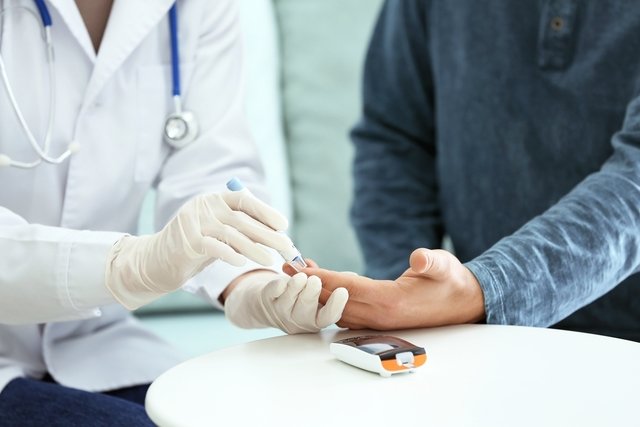Insulin resistance occurs when the body’s cells do not respond to the action of this hormone and have difficulty absorbing glucose from the blood, which stimulates the production of more insulin, increasing the levels of this hormone in the blood.
Insulin resistance can arise due to some factors, such as genetic changes and obesity, for example, and often does not cause symptoms. However, over time, the pancreas can decrease insulin production, increasing blood glucose levels and the risk of developing type 2 diabetes.
The diagnosis of insulin resistance must be made by an endocrinologist, or general practitioner, who will evaluate the person’s and family’s health history, and may also request blood tests, such as blood glucose, insulin or HOMA index.

Main symptoms
The main symptoms that may arise in insulin resistance are:
- Excessive thirst;
- Increased hunger;
- Frequent urge to urinate;
- Excessive tiredness;
- Blurry vision;
- Headache;
- Dark skin on the armpits, back or neck, a condition called acanthosis nigricans.
People with insulin resistance also have high insulin levels, which balances blood sugar levels, preventing symptoms from developing.
However, over time, the pancreas can reduce insulin production, causing blood glucose levels to rise, causing these symptoms to appear.
Difference Between Insulin Resistance and Prediabetes
Pre-diabetes is a condition that precedes type 2 diabetes, where fasting blood glucose levels are between 100 and 125 mg/dl, and may be caused by insulin resistance. Understand better what pre-diabetes is.
Insulin resistance is a condition where the body’s cells do not respond to the action of this hormone. However, when insulin resistance is not treated, the pancreas can decrease insulin production, causing increased blood glucose levels and prediabetes.
How the diagnosis is made
The diagnosis of insulin resistance must be made by an endocrinologist, or general practitioner, who will evaluate the symptoms and signs presented, and the person’s health and family history.
To assess your risk of insulin resistance, make an appointment with an endocrinologist in the region closest to you:
Taking care of your health has never been easier!
Furthermore, to confirm the diagnosis, the doctor may also order some blood tests, such as:
1. Fasting blood glucose test
As insulin resistance worsens, blood glucose levels may also become elevated during fasting. Therefore, the doctor may order a fasting blood glucose test.
Fasting blood glucose is taken after 8 to 12 hours of fasting, with a blood sample being collected and then evaluated in the laboratory. The reference values are:
- Normal: inferior a 99 mg/dL;
- Altered fasting blood glucose: entre 100 mg/dL e 125 mg/dL;
- Diabetes: equal to or greater than 126 mg/dL in at least two exams.
It is important to remember that during insulin resistance, glucose levels can still be balanced in the blood, because the body stimulates the pancreas to produce greater amounts of insulin.
2. Oral glucose intolerance test (OGTT)
This test is an examination carried out by measuring the blood glucose value before and after ingesting around 75 g of a sugary liquid. The interpretation of this test can be done 2 hours after ingesting the liquid, as follows:
- Valor normal: up to 140 mg/dL;
- Insulin resistance: entre 140 e 199 mg/dl;
- Diabetes: equal to or greater than 200 mg/dl.
The oral glucose tolerance test, or glycemic curve, is usually requested only when the fasting glucose test is altered. Understand better how the glycemic curve is created.
3. HOMA Index
Another way to diagnose insulin resistance is through the HOMA index, which is a measurement that helps evaluate insulin resistance (HOMA-IR) and pancreas functions (HOMA-Beta). Normal HOMA index values are generally as follows:
- HOMA-IR Reference Value: inferior a 2,5;
- HOMA-Beta Reference Value: between 167 and 175.
These reference values may vary according to each laboratory, and may also vary in the case of people with a very high Body Mass Index (BMI). Therefore, this exam must always be interpreted by the doctor.
Insert the results of your blood glucose and insulin test into the calculator below to find out your HOMA-IR:
Possible causes
Although the exact cause of insulin resistance is not yet known, some factors may be related to the emergence of this condition, such as having family members with insulin resistance or diabetes, for example.
Other factors that can also promote the development of insulin resistance are:
- Sedentary lifestyle;
- Overweight or obesity, especially with excess abdominal fat;
- Fat in the liver and pancreas;
- Diet rich in carbohydrates and saturated fats.
Furthermore, some hormonal changes can also increase the chances of developing insulin resistance, including polycystic ovarian syndrome, Cushing’s syndrome and hypothyroidism, for example.
What is the treatment like?
The treatment of insulin resistance must be carried out with the guidance of a general practitioner or endocrinologist, including monitoring blood glucose levels and lifestyle changes, such as exercising regularly, losing weight and maintaining a healthy and varied diet. See what to eat to control insulin resistance.
In cases of very increased risk for diabetes, the doctor may also prescribe the use of medications, such as metformin, a medicine that improves insulin sensitivity in cells, helping to control blood glucose levels.

Sign up for our newsletter and stay up to date with exclusive news
that can transform your routine!
Warning: Undefined array key "title" in /home/storelat/public_html/wp-content/plugins/link-whisper-premium/templates/frontend/related-posts.php on line 12
Warning: Undefined array key "title_tag" in /home/storelat/public_html/wp-content/plugins/link-whisper-premium/templates/frontend/related-posts.php on line 13



